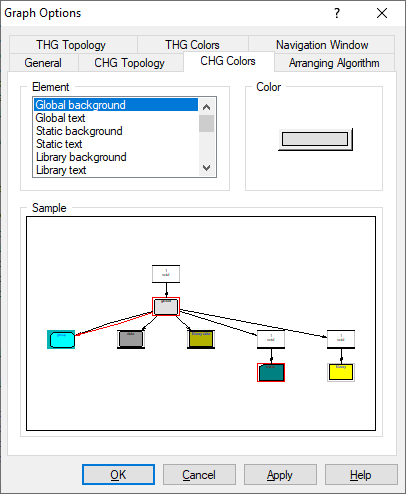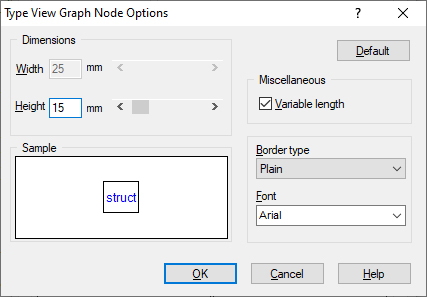Graphical Explorer Options
Graph Options dialog box is divided into seven tabs.
General
CHG Topology
CHG Colors
Arranging Algorithm
THG Topology
THG Colors
Navigation Window
General
Scrolling / Absolute step
Determines the absolute step of graph image scrolling.
Scrolling / Relative step
Determines the relative step of graph image scrolling.
Scrolling / Relative
On scrolling Graph using arrow keys, the picture is moved in accordance with the screen size percentage set in Scrolling / Relative step.
Scrolling / Absolute
On scrolling Graph using arrow keys, the picture is moved in accordance with the number of Graph size units set in Scrolling / Absolute step.
In the Scrolling part you can set the manner of scrolling for the window in which the graph is displayed. If you select the option Relative, scrolling will be relative in relation to graph width for the value in the corresponding edit control. If you select the option Absolute, scrolling will be absolute for the number of pixels entered in the corresponding edit control.
Zooming / Relative step
Determines the relative step of graph image zooming.
Zooming / Maximal depth
Determines the maximum zooming depth, that is, the maximum number of zooming operations.
Zooming / Originated
Specifies whether the zooming will be carried out in relation to the starting node or to the currently visible part of the graph. The node will be placed on the left side of the screen, a third of the way down and half way across.
Reduced mode / Start Graph in reduced mode
Determines whether multiple edges between two nodes will be grouped.
Reduced mode / Display edge count in reduced mode
Determines if the number of grouped multiple edges in reduced mode will be displayed by the group edge.
Maximal recursive depth
Determines the maximum expansion depth while executing Graph / Recursive calls within or Graph / Recursive successors command.
Maximal undo depth
Determines the maximum number of Undo operations.
Start depth
Determines the starting depth for flowchart.
Abbreviate titles in Tabs
Determines whether Graph titles should be abbreviated in tabs to occupy less space.
Show standard library functions
Determines whether standard library function nodes will be displayed.
Start type view graph
Determines if type view graph will be showed when you show Call-Hierarchy graphs from the shortcut menus in the Editor, Browser, or Project Explorer.
Start mixed view graph
Determines if mixed view graph will be showed when you show Call-Hierarchy graphs from the shortcut menus in the Editor, Browser, or Project Explorer.
CHG Topology
Orientation
Determines the way function graphs will be oriented.
Top to down
Highest level nodes will appear on top.
Left to right
Highest level nodes will appear on the left.
Node setup
Opens a dialog box in which node dimensions and parameters in Call-Hierarchy graphs can be set. See "Node setup"
Distance between nodes per axis
Determines the horizontal and vertical distance between nodes in Call-Hierarchy graphs, expressed by currently selected measurement units.
Default
Sets default values in the CHG Topology tab.
Show data nodes
Specifies whether data nodes will be displayed
Show library data
Specifies whether library data nodes will be displayed
Show standard library functions
Specifies whether library function nodes will be displayed
Show parameter nodes
Specifies whether parameter nodes will be displayed
Node setup
Width
Initial node width
Height
Initial node height
Show file name
Specifies whether the name of the source file in which the symbol displayed in the node is defined will be displayed.
Border type
Specifies whether node has shadow and shadow position relative to node.
Font
Specifies the font used for node text
Sample
Displays an example of a graph for the settings specified.
CHG Colors
Public background
Determines the background color of public functions in function graphs.
Public text
Determines the text color of public functions in function graphs.
Static background
Determines the background color of static functions in function graphs.
Static text
Determines the text color of static functions in function graphs.
Library background
Determines the background color of library functions in function graphs.
Library text
Determines the text color of library functions in function graphs.
Parameter background
Determines the background color of library functions in function graphs.
Parameter text
Determines the text color of library functions in function graphs.
Group background
Determines the background color of group nodes in Graphs.
Group text
Determines the text color of group nodes in Graphs.
Selected node
Determines the color of selected nodes in Graphs.
Selecting node
Determines the color of selecting nodes in Graphs.
Selected edge
Determines the color of selected edges in Graphs.
Selecting edge
Determines the color of selecting edges in Graphs.
Windows background
Determines the window background color of Call-Hierarchy graphs.
Breakpoint
Determines the breakpoint color of Call-Hierarchy graphs.
Execution point
Determines the execution point color of Call-Hierarchy graphs.
Color
Specifying the color of a particular element is carried out by clicking the button with the colored rectangle which opens the standard Windows Color dialog for color selection. Color change effects of a particular graph element can be viewed immediately in the Sample part. A button with a colored rectangle shows the current color of the element selected in the List Box.
As the number of elements for which color can be set is large, DA-C will take care of some of these tasks for you. That is, you will set public function node color, and DA-C will on the basis of the color selected come up with a color one shade darker for global data nodes. The same applies for static and library data and functions.
Sample
Displays an example according to current settings.
Arranging Algorithm
Minimized edge length
Determines the arranging algorithm type. The arranging algorithm prefers minimal distances between nodes.
Deep function calls hierarchy
Determines the arranging algorithm type. Call-Hierarchy Graph is arranged so that function nodes are arranged in levels. Deep hierarchy for function calls is preferred.
Library functions always on last level
Specifies that nodes representing library functions and data are always arranged at lowest graph level. This setting works only when Deep Function Calls Hierarchy arranging algorithm is selected.
THG Topology
Top to bottom / Left to right
Determines the way type graphs will be oriented.
Type view
Opens the Type View Graph Node Options dialog box. Use this dialog box to set node properties. See "Type View Graph Node Options"
Mixed view
Opens the Mixed View Graph Node Options dialog box. Use this dialog box to set node properties. See "Type View Graph Node Options"
X / Y
Determines the horizontal and vertical distance between nodes in Call-Hierarchy graphs, expressed by currently selected measurement units.
Default
Sets the default values in the THG Topology tab distances.
Show simple types in mixed view
Determines if simple type nodes will be displayed in mixed view graphs.
Type View Graph Node Options or Mixed View Graph Node Options
Width
Initial node width
Height
Initial node height
Variable length
If this option is selected, node width depends on the width of node content. If the option is not selected, node width is determined by the value in the Width box.
Border type
Specifies whether node has shadow and shadow position relative to node.
Font
Specifies the font used for node text
THG Colors
Type View Background
Determines the background color of type nodes in type view graphs.
Type View Text
Determines the color of the first text line in nodes in type view graphs.
Type View Description
Determines the color of the second text line in nodes in type view graphs.
Mixed View Complex Background
Determines the background color of complex type nodes in mixed view graphs.
Mixed View Complex Text
Determines the text color of complex type nodes in mixed view graphs.
Mixed View Member Background
Determines the background color of member nodes in mixed view graphs.
Mixed View Member Text
Determines the text color of member nodes in mixed view graphs.
Mixed View Simple Background
Determines the background color of simple type nodes in mixed view graphs.
Mixed View Simple Text
Determines the text color of simple type nodes in mixed view graphs.
Mixed View "is of type" edge
Determines the color of the edges that connects member nodes with the nodes of corresponding types in Mixed View Graphs.
Windows background
Determines the window background color of the Call-Hierarchy Graphs.
Color
Opens a Color dialog box in which the color of the element selected from the Element list can be set.
Navigation Window
DA-C window corner / Top-left
Displays the Navigation window at the top left corner of the DA-C window.
DA-C window corner / Top-right
Displays the Navigation window at the top right corner of the DA-C window.
DA-C window corner / Bottom-left
Displays the Navigation window at the bottom left corner of the DA-C window.
DA-C window corner / Bottom-right
Displays the Navigation window at the bottom right corner of the DA-C window.
Graph corner / Top-left
Displays the Navigation window at the top left corner of the Graph.
Graph corner / Top-right
Displays the Navigation window at the top right corner of the Graph.
Graph corner / Bottom-left
Displays the Navigation window at the bottom left corner of the Graph.
Graph corner / Bottom-right
Displays the Navigation window at the bottom right corner of the Graph.
Show Navigation window at startup
When the Graph is opened, the Navigation window will open automatically.









 Copyright © 1993-2022, RistanCASE PR
Copyright © 1993-2022, RistanCASE PR